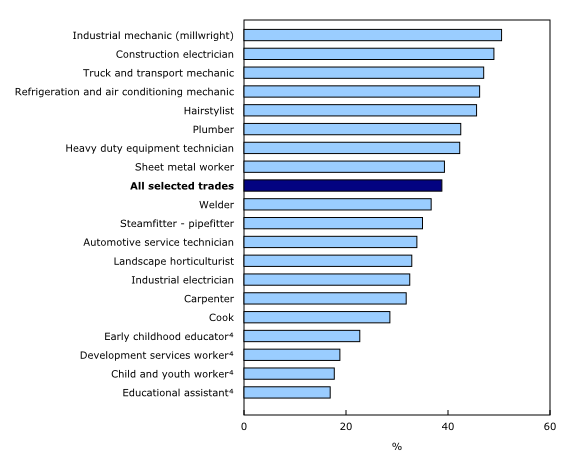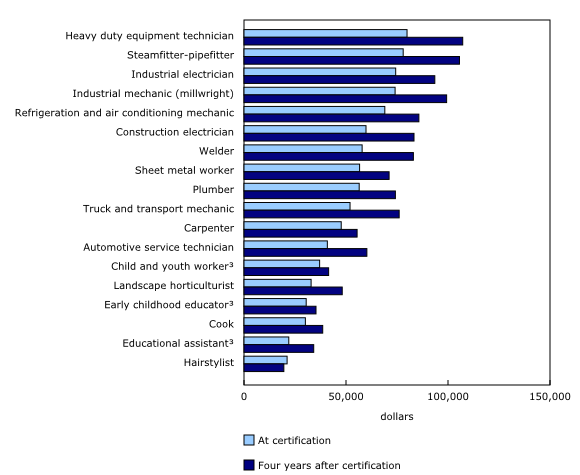Pathways and earnings indicators for registered apprentices in Canada
Archived Content
Information identified as archived is provided for reference, research or recordkeeping purposes. It is not subject to the Government of Canada Web Standards and has not been altered or updated since it was archived. Please "contact us" to request a format other than those available.
Released: 2018-12-05
Despite short-term fluctuations, overall strong economic growth over the last two decades in areas such as construction and natural resources, combined with an aging workforce, have contributed to increased demand for skilled tradespeople in Canada.
The total number of people registered in apprenticeship programs in Canada has grown sharply since the end of the 1990s, rising from 199,074 in 2000 to 405,699 in 2017. However, the number of new registrations and certificates granted has declined in recent years in the wake of fluctuations in the economy such as the 2008-2009 recession and lower oil prices in 2014-2015.
Moreover, data from the census suggest the workforce is aging at a faster pace in the trades. Among workers who had a certificate of apprenticeship or a certificate of qualification, 26.1% were aged 55 years and older in 2016, up from 23.2% in 2011. Among those with a university degree at the bachelor level or above, the share of workers aged 55 years and older increased by less than one percentage point, rising from 16.8% in 2011 to 17.7% in 2016.
After two annual declines, the number of new registrations in apprenticeship programs stabilizes
Focusing on year-over-year new registrations to apprenticeship programs, the number of registrations edged down 0.6% in 2017 compared to the previous year. This decline is smaller than those in 2015 (-14.7%) and 2016 (-9.7%), which coincided with the significant decrease in crude oil prices from mid-2014 to the end of 2016, resulting in higher unemployment in the resource-rich provinces of Alberta, Saskatchewan and Newfoundland and Labrador.
From 2016 to 2017, total employment rose by 1.9% in Canada, marking the largest employment growth in 10 years. These employment gains may have contributed to improved apprenticeship training opportunities in some sectors during this period. Ontario, in particular, reported 6.8% more new registrations from 2016 to 2017, largely due to gains in construction and automobile manufacturing related major trade groups. Prince Edward Island, Nova Scotia, New Brunswick and the territories also recorded an increase in new registrations in apprenticeship programs in 2017.
Despite the increasing need for skilled tradespeople, the number of certificates awarded to individuals who completed the necessary steps to become qualified in a trade has declined over the past few years. The number of certificates granted fell from 55,230 in 2016 to 51,150 in 2017 (-7.4%). This was consistent with declines in previous years, where the number of certificates fell from 59,409 in 2014 to 55,230 in 2016 (-7.0%).
Many apprentices take longer than their program duration to receive a certificate
When looking at the progression of apprentices in 19 apprenticeship programs from 2010 to 2016, 20.2% of those who newly registered to a program in 2010 received their certification within their program duration, while 38.8% did so within 1.5 times of the program duration.
There are a number of factors influencing time to certification. These include completion of on-the-job hours, technical training, compulsory status of programs and the successful completion of the certification exam.
Half of industrial mechanic (millwright) and construction electrician apprentices receive certification within six years
Half of those who registered in the industrial mechanic (millwright) (50.5%) and the construction electrician (49.0%) programs in 2010 obtained their certification within 1.5 times (six years) of the normal program duration of four years, the highest certification rates among the selected trades.
The median time they took to certify was close to the four-year program duration, 3.9 years for industrial mechanic (millwrights) and 4.3 years for construction electricians.
Meanwhile, 45.6% of apprentices registered in the hairstylist program, the most popular program among female apprentices, certified within 1.5 times of their two-year program duration. This was the highest certification rate among female-dominated trades.
The lowest certification rates and the highest discontinuation rates are found among female-dominated trades
The female-dominated trades of early childhood educator, child and youth worker, developmental services worker, and educational assistant accounted for 23.6% of new registrations among women in selected trades in 2010. They are only considered designated trades in Ontario.
Apprentices who registered in the education assistant (16.9%), child and youth workers (17.7%), developmental services worker (18.8%) and early childhood educator (22.7%) programs in 2010 had the lowest certification rates among the selected trades, with less than one in four apprentices obtaining their certification within 1.5 times of the program duration.
Over the same period, almost 6 in 10 of those who had registered in the child and youth worker program (59.7%) and the early childhood educator program (56.2%) had discontinued, the highest rates among the selected trades.
Women in male-dominated trades have lower certification and higher discontinuation rates
Women who registered in male-dominated trades in 2010, such as construction electricians and carpenters, had lower certification rates and higher discontinuation rates than their male counterparts.
Among women who registered as construction electricians, just over one-third (35.6%) had certified within six years (1.5 times the program duration), compared with half of men (49.5%).
While women had lower certification rates than their male counterparts, among those who certified, the median time to certification was similar, at 4.4 years for women and 4.3 years for men.
Women were also more likely to leave their construction electrician program than men. Almost half (47.1%) of women discontinued within 1.5 times of the program duration (six years), compared with just under one-third (30.7%) of men.
According to the 2015 National Apprenticeship Survey, women who discontinued their programs were more likely than men to report "personal or family issues," or "disliked the work," as reasons for not completing their program. Meanwhile, "job instability," or "received a better job offer," were the most common reasons men cited for discontinuing their apprenticeship programs.
The median employment income at the time of certification is over $50,000
For apprentices who received their certificates in 1 of the 18 selected apprenticeship programs in 2010, the median employment income at the time of certification was $52,030.
Among the selected trades, those who certified in the heavy duty equipment technician ($79,920), steamfitter–pipefitter ($78,030) and industrial electrician ($74,350) trades had the highest median employment income at certification. These are all male-dominated trades.
In turn, hairstylist had the lowest median employment income ($21,130), followed closely by educational assistant ($21,950) and cook ($30,090). These were female-dominated trades, except the cook trade where the difference in the proportion of men (67%) and women (33%) was smaller.
Among largely male-dominated trades, automotive service technician had the lowest median employment income at $40,860. This was $3,790 higher than the median employment income of the child and youth worker trade ($37,070), the female-dominated trade with the highest income at the time of certification.
Four years after certification, apprentices in two trades make over $100,000
Four years after certification, those who certified in the heavy duty equipment technician ($107,220) and in the steamfitter–pipefitter ($105,620) trades continued to have the highest income, increasing on average by approximately 35% during this period. Industrial mechanic (millwright) ($99,320) replaced the industrial electrician trade with the third highest employment income among the trades.
The highest employment incomes were still found in male-dominated trades four years after certification. The employment income of those who certified in the heavy duty equipment technician trade ($107,220) was more than double that of those who certified in the child and youth worker trade ($41,490), which had the highest median employment income among female-dominated trades.
Note to readers
Context
This is the last of three releases highlighting results on postsecondary students and apprentices, and their labour market outcomes. Data on postsecondary enrolments and graduates were released on November 28 and results on postsecondary graduate outcomes were released on December 4.
This release includes data from the Education and Labour Market Longitudinal Platform (ELMLP), from 2008 to 2016, and data from the 2017 Registered Apprenticeship Information System (RAIS). More information on the ELMLP, the RAIS, and the methodology used to calculate the pathways and earnings indicators is available online in "Pathways and earnings indicators for registered apprentices in Canada," which is part of the publication the Technical Reference Guides for the Education and Labour Market Longitudinal Platform (37200001) and in the Registered Apprenticeship Information System Guide.
Data, definitions and concepts
Pathways and earnings indicators were derived from the 14 Red Seal trades with the largest number of registrations in Canada, along with five non-Red Seal trades. Four of the five non-Red Seal trades, child and youth worker, developmental services worker, early childhood educator and educational assistant are only considered designated trades with apprenticeship programs in Ontario. For more information on the concepts and the methodology used in this study, consult "Pathways and earnings indicators for registered apprentices in Canada," which is part of the publication Technical Reference Guides for the Education and Labour Market Longitudinal Platform (37200001)and in the Registered Apprenticeship Information System Guide.
Certification: The requirements for granting a certificate varies by jurisdiction in Canada. In most instances, an apprentice is issued a certificate if he or she completes such requirements as supervised on-the-job training, technical training as well as passing one or more examinations. Most trade qualifiers, meanwhile, become certified once they pass an examination.
Compulsory trades: are trades where workers are required to undertake or complete an apprenticeship program to be able to be employed in the trade. Jurisdictions determine the compulsory or non-compulsory status of designated trades. As such compulsory or non-compulsory status of a designated trade varies across jurisdictions.
Designated trades: provincial and territorial jurisdictions determine the trades for which apprenticeship training is made available. These are referred to as designated trades. The jurisdictions also determine which of the designated trades require certification in order to work unsupervised in the trade. The list of designated trades varies considerably between the jurisdictions. Data from the Registered Apprenticeship Information System includes only those trades that are designated in at least one province or territory.
Discontinuation: The proportion of apprentices who discontinued a given apprenticeship program after their registration date.
Registered apprentices: are persons who are in a supervised work training program in a designated trade in their province or territory. The apprentice must be registered with the appropriate governing body (usually a ministry of education or labour, or a trade specific industry governing body) to complete the training. Some apprentices could be registered to more than one apprenticeship program at the same time.
Red Seal and non-Red Seal Programs
The Red Seal Program sets common standards to assess the skills of tradespersons across Canada in trades, referred to as the "Red Seal" trades. Tradespersons who meet the Red Seal standards, through examination, receive a Red Seal endorsement on their provincial/territorial trade certificates.
Non-Red Seal trades, meanwhile, do not have interprovincial standards. Many non-Red Seal trades do not have an examination requirement to work in the trade.
Total registrations: Total number of registrations who were carried forward from the previous year, new registrations and reinstatements.
New registrations: New entrants to any apprenticeship program from January 1, 2017, to December 31, 2017.
Employment income
Employment income includes employment earnings (wages and salaries, commissions from employment, training allowances, tips and gratuities, tax exempted Indian employment income) and net self-employment income (net income from business, profession, farming, fishing and commissions). It is adjusted for inflation and presented in 2016 constant dollars.
Products
The guide "Pathways and earnings indicators for registered apprentices in Canada", which is part of the publication Technical Reference Guides for the Education and Labour Market Longitudinal Platform (37200001) was also released today.
New data from the Registered Apprenticeship Information System are now available.
Contact information
For more information, or to enquire about the concepts, methods or data quality of this release, contact us (toll-free 1-800-263-1136; 514-283-8300; STATCAN.infostats-infostats.STATCAN@canada.ca) or Media Relations (613-951-4636; STATCAN.mediahotline-ligneinfomedias.STATCAN@canada.ca).
- Date modified:



